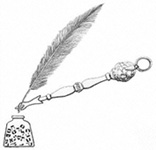|
Creation
The letters, which for millennia have served
as an impetus to the Jewish creative process, are in Jewish legend
intimately associated with the very act of Creation. The Midrash
relates that when God was about to create the world, He sought out
the aid of assistants. The Torah came forward to offer the help
of "twenty-two laborers," the twenty-two letters of the Hebrew alphabet
that in their various combinations comprise the text of the Holy
Writ. Each letter then stepped forth to plead its particular preeminence.
The only letter that refrained was the modest aleph. Its humility
was later rewarded, when it was accorded the honor of beginning
the Ten Commandments. |
 Aleph-Beth (Alphabet)
Aleph-Beth (Alphabet) 
Every single letter of the Torah is considered so important that he
who corrects even one letter in a Torah scroll is regarded by tradition
as though he had written that Torah himself. Thus, there developed the
custom whereby each Jew symbolically fulfills the mitzvah (commandment)
of writing a scroll. The sofer (scribe) writes only the outlines
of the letters at the beginning and at the end. These letters are then
completed in a ceremony known as siyyum ha-Torah (the completion
of the Torah). The honor is bestowed on those present to ink in the
outlined letters.
Although one may touch the parchment of the Torah while writing the
letters, ordinarily it is forbidden to touch a Torah scroll with one's
fingers. Instead, a ceremonial object known as a yad (hand) is
used to point to the words while reading from the Torah. The yad
is usually made of silver, in the form of a hand with a pointed index
finger.

Reflections on creating the pictograph for Aleph
The two most difficult letters were aleph and vav. A word
which had been originally chosen for aleph was echad (one).
Echad appealed to me since it evoked the idea of the Oneness
of God. However, this created the problem of illustrating the oneness
of God without violating the Second Commandment.... I thought a possible
solution might be a drawing of a mezuzah since it encloses the
verses from Deuteronomy which proclaims God's Oneness. According to
Maimonides, "But the commandment of the mezuzah, man is reminded,
when entering or departing, of God's Oneness, and is stirred into love
for Him."
Furthermore each letter of the Hebrew alphabet has a numerical equivalent.
Since the numerical equivalent of aleph is one, this also attracted
me to the word echad. In the end, echad was rejected because
of the difficulty with the Second Commandment. Besides, the drawing
of a mezuzah was just not that interesting. So I chose alephTbet.
It offered more interesting artistic opportunities and was closer to
my original conception than any other possibility.
|
 Dr.
Mark Podwal is the author and illustrator of numerous books, including
A Book of Hebrew Letters, A Jewish Bestiary, and
Freud's da Vinci. His work is in the collections of the
New York Metropolitan Museum of Art, the Library of Congress,
the Jewish Museum (NY) and the National Gallery in Prague. His
drawings and watercolors are presented by Forum Gallery, New York. Dr.
Mark Podwal is the author and illustrator of numerous books, including
A Book of Hebrew Letters, A Jewish Bestiary, and
Freud's da Vinci. His work is in the collections of the
New York Metropolitan Museum of Art, the Library of Congress,
the Jewish Museum (NY) and the National Gallery in Prague. His
drawings and watercolors are presented by Forum Gallery, New York.
|
|
|
|
|